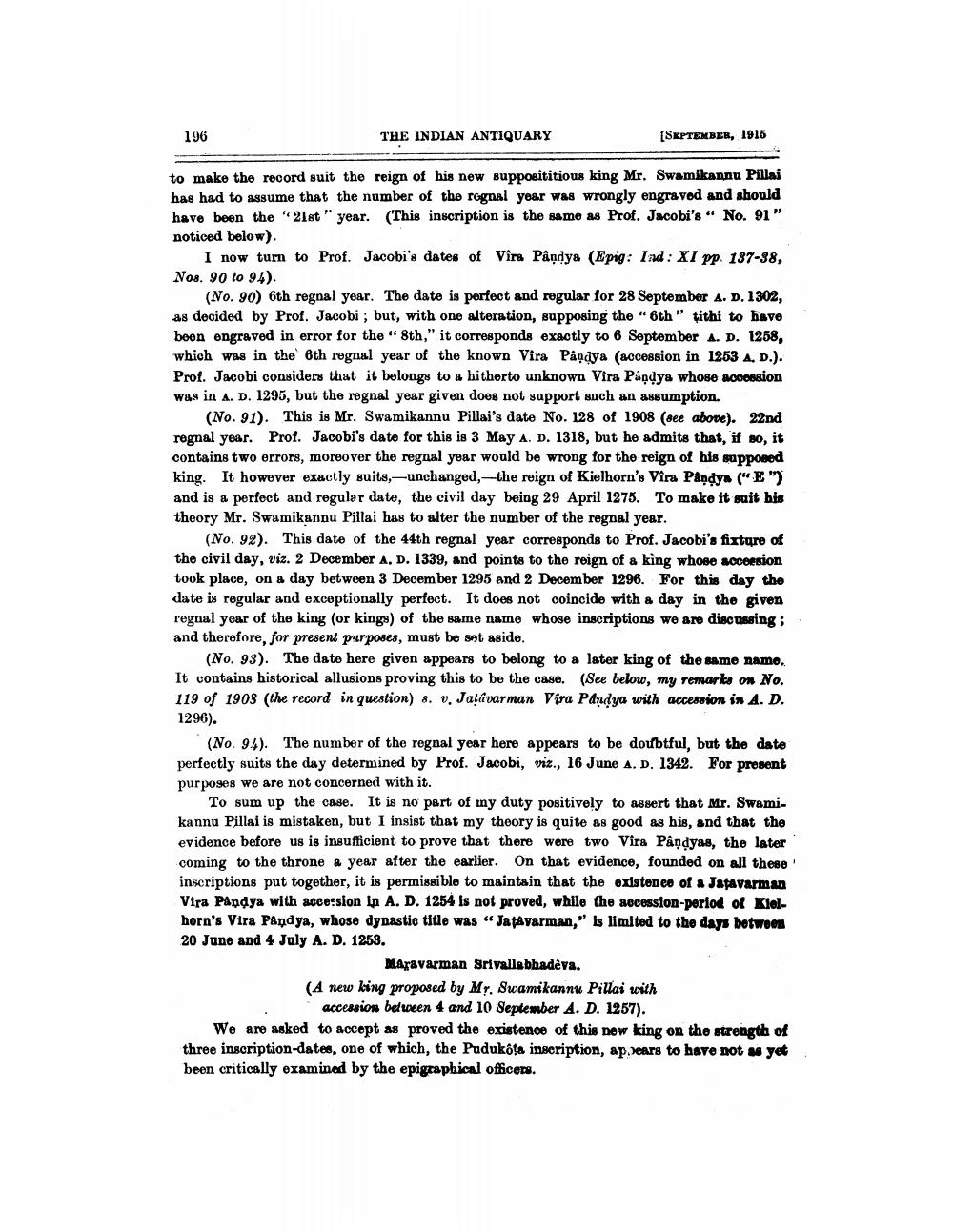________________
196
THE INDIAN ANTIQUARY
(SEPTEMBER, 1915
to make the record suit the reign of his new supposititious king Mr. Swamikannu Pillai has had to assume that the number of the regnal year was wrongly engravod and should have been the 21st " year. (This inscription is the same as Prof. Jacobi's “ No. 91 " noticed below).
I now turn to Prof. Jacobi's dates of Vîra Pandya (Epig: Ind: XI pp. 187-38, Nos. 90 to 94).
(No. 90) 6th regnal year. The date is perfect and regular for 28 September A. D. 1302, as decided by Prof. Jacobi; but, with one alteration, supposing the "6th" tithi to have been engraved in error for the " 8th," it corresponds exactly to 6 September A. D. 1258, which was in the 6th regnal year of the known Vira Pandya (accession in 1253 A. D.). Prof. Jacobi considers that it belongs to a hitherto unknown Vira Pagdya whose accession was in A. D. 1295, but the regnal year given does not support such an assumption.
(No. 91). This is Mr. Swamikannu Pillai's date No. 128 of 1908 (see above). 22nd regnal year. Prof. Jacobi's date for this is 3 May A. D. 1318, but he admits that, if so, it contains two errors, moreover the regnal year would be wrong for the reign of his supposed king. It however exactly suits, unchanged,--the reign of Kielhorn's Vira Påndys ("E" and is a perfect and regular date, the civil day being 29 April 1275. To make it suit bis theory Mr. Swamikannu Pillai has to alter the number of the regnal year.
(No. 92). This date of the 44th regnal year corresponds to Prof. Jacobi's fixtare of the civil day, viz. 2 December A.D. 1339, and points to the reign of a king whose accoesion took place, on a day between 3 December 1295 and 2 December 1296. For this day the date is regular and exceptionally perfect. It does not coincide with a day in the given regnal year of the king (or kings) of the same name whose inscriptions we are discussing; and therefore, for present purposes, must be set aside.
(No. 93). The dato here given appears to belong to a later king of the same namo. It contains historical allusions proving this to be the case. (See below, my remarks on No. 119 of 1908 (the record in question) 8. v. Jatavarman Vira Pandya with accession in A. D. 1296).
(No. 94). The number of the regnal year here appears to be doubtful, but the date perfectly suits the day determined by Prof. Jacobi, viz., 16 June A.D. 1342. For present purposes we are not concerned with it.
To sum up the case. It is no part of my duty positively to assert that Mr. Swami. kannu Pillai is mistaken, but I insist that my theory is quite as good as his, and that the evidence before us is insufficient to prove that there were two Vira Pândyas, the later coming to the throne a year after the earlier. On that evidence, founded on all these inscriptions put together, it is permissible to maintain that the existence of a Jatavarman Vira Pandya with accession in A. D. 1254 is not proved, while the accession-period of Kielhorn's Vira Pandya, whose dynastic title was " Jatavarman," is limited to the days between 20 June and 4 July A. D. 1258.
Maravarman Srivallabhadeva. (A new king proposed by Mr. Swamikannu Pillai with
accession between 4 and 10 September A. D. 1257). We are asked to accept as proved the existence of this new king on the strength of three inscription dates, one of which, the Pudukota inscription, ap.ears to have not we yet been critically examined by the epigraphical officers.




